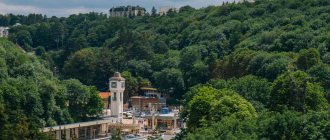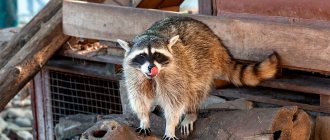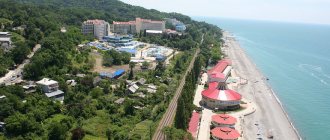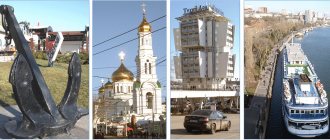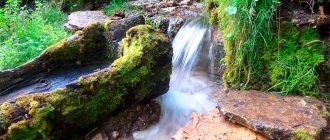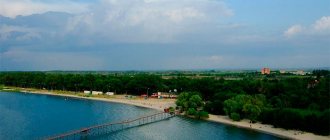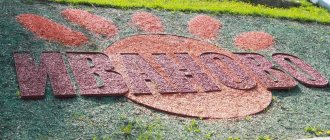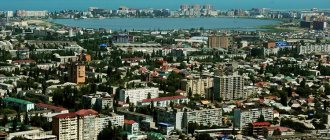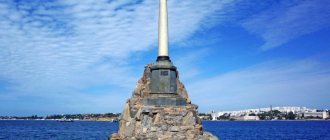| What to see on your own What to see in winter Museums Stories, routes and tips from tourists Trips for 1 day Where to stay in Essentuki Interesting excursions |
Essentuki is the youngest of the Caucasian Mineral Waters resorts. The mineral water springs discovered on its territory by F. P. Haaz in 1811 did not at first interest doctors; these unique waters had to wait for recognition for more than ten years. The founding date of the city is 1825. Now Essentuki is a large drinking and balneological resort of federal significance, where diseases of the gastrointestinal tract, liver and metabolism are treated with mineral waters and healing mud of Lake Tambukan.
People rarely come to Essentuki for purely tourist purposes, and during the standard two-week period during the treatment process, holidaymakers get to know all the main attractions of the city without haste. As a rule, vacationers from neighboring resort towns come for one day during their free time from procedures. This is not difficult to do; the cities are connected by commuter rail.
A few facts about Essentuki
- The name of the city was given by the name of the local nobleman Essen, who lived in these areas during the era of the Golden Horde. He was buried here, on the Essen-Tuk hill, located on the left bank of the Bolshaya Essentuchek River in a specially built mausoleum. Now little remains of the structure, but some of its fragments are kept in the local history museum.
- The official date of formation of Essentuki is considered to be 1825. The base for it was a small fortification of the Volga Cossacks, built several decades earlier.
- The first mineral springs were discovered here by the very Cossacks who served as commandant in the region. It was they who noticed the unusual streams flowing into the small river Kislusha.
- The first to explore and describe the mineral springs of Essentuki was Professor A.P. Nelyubin. The doctor of medicine's list included 20 sources, and he assigned a serial number to each of them.
- The first vacationers appeared in Essentuki in 1835. By this time, the city had acquired several baths, which were supplied with water from nearby mineral springs.
- Russians began to show real interest in the resort at the beginning of the 20th century, when several hydropathic clinics and specialized sanatoriums were built in these places.
- After the end of the civil war, in the 1920s, Essentuki was given the status of a resort town, and Soviet citizens began to come here en masse for treatment and recreation.
- The population of Essentuki is 114.8 thousand people.
- The distance to the capital of the region, Stavropol, is 200 km.
- Essentuki is located between Pyatigorsk and Kislovodsk, the distance to these resorts is about 23 km.
Essentuki Railway Station
Address: Essentuki, Vokzalnaya st., 1A.
The historic railway station building at Essentuki station was built in 1893 in the Old Russian style. The station is located in the city center, next to the Resort Park. Long-distance trains and commuter trains arrive at the station. In 1957, a 14-meter obelisk Eternal Glory was erected on Station Square at the burial site of 11 people who died at the hands of the White Guards.
Internationalnaya Street, the former Main Kursovaya, begins from Station Square. Walking along it, you can see interesting old villas, hotels and mansions.
Best hotels in Essentuki
Related materials:
- 31 attractions of Novorossiysk to visit
- 32 sights of Kronstadt that are worth visiting
- 26 attractions of Azov that are worth visiting
- 34 best sights in Omsk that are worth seeing
- 29 attractions of Makhachkala that are worth visiting
- 29 best attractions of Chelyabinsk,…
- 33 attractions of Bakhchisaray that are worth visiting
- 28 best attractions in Belgorod,…
- 26 attractions of Svetlogorsk that…
Did you like the article? Share with friends:
1
theatre square
While viewing the sights of Essentuki, you cannot pass by the central square of the city, called Teatralnaya. This place got its name from the huge concert hall named after Chaliapin, which in former years was called the Touring Theater. In addition to the theater, there is a large department store on the square - a real Mecca for those who like to shop. There is also a stage where various celebrities perform in the summer.
Along with the concert hall and department store, Teatralnaya Square in Essentuki is decorated with another attraction - the singing fountain. It is considered one of the largest and most beautiful fountains in the southern part of Russia. It is located right in front of the stage, and is made in such a way that water flows directly from under the asphalt.
The area of the fountain is about 400 square meters. m. It is not fenced in anything, so children love to run around it, dodging powerful vertical water jets that erupt every minute from pipes hidden under the asphalt. In the evenings, a light and music accompaniment is turned on at the fountain, which creates a real show that attracts many spectators.
What to see in Essentuki in 1 day on your own
Essentuki is a small city, all its main attractions are located compactly within the resort area, it is quite possible to see them in one day if you plan routes wisely. We will try to help you with this by arranging the attractions in an order that is convenient for inspection.
Train Station
If you come to Essentuki by train, pay attention to the railway station . The Essentuki station was opened in 1893, and in May 1894, regular train service began on the Mineralnye Vody - Kislovodsk section. From the station, walk along Internatsionalnaya Street, where houses from the early 20th century have been preserved, to Teatralnaya Square.
Railway station "Essentuki" Photo: © Natalia Semchina
theatre square
Theater Square is the main square of Essentuki; all the main city events, folk festivals, festivals, concerts and fairs take place here, and an elegant Christmas tree is set up for the New Year. The square is a pedestrian zone, the main attraction here, of course, is the large Singing Fountain , the jets of which flow from under the asphalt. On hot summer days it creates a pleasant coolness, and in the evenings the light and music accompaniment is turned on, and the bright spectacle delights local residents and guests of the city.
Singing fountain on Teatralnaya Square Photo: © Anna Kudryavtseva
Among the favorite attractions of tourists on the square is the “Zero Kilometer of Love ,” where lovers make dates under the protection of Cupid standing on a pedestal, and tourists love to take pictures. The square also houses the Central Entrance to the Resort Park.
“Zero kilometer of love” Photo: © Anna Kudryavtseva
Concert Hall named after. F. I. Shalyapina
The square is called Teatralnaya because here is the Fyodor Chaliapin Concert Hall , a former touring theater where all celebrities give concerts and theaters that come to Essentuki on tour give performances. On such days, vacationers are brought here from sanatoriums in neighboring resort towns.
The Concert Hall is the largest concert venue in the resort, with three halls. A large hall with modern equipment and excellent acoustics, which can accommodate about one and a half thousand spectators. Touring theater and ballet performances and concerts take place here. A small cozy chamber music hall for 80 people and an organ hall. Essentuki can be proud; not every city has an organ! An organ from the German company Walker was installed in the concert hall in 2011; it is one of the largest organs in the country. The International Organ Music Festival is now held annually in Essentuki, which attracts Russian and foreign performers.
Concert Hall named after. F,I. Chaliapin Photo: © Natalia Semchina
Resort Park
Now it is difficult to imagine that the site of the park was once bare steppe, and the beautiful resort park of Essentuki is the creation of human hands.
The history of the resort park began in 1847, when Count Vorontsov, who in those years was the governor of the Caucasus, decided to green the Essentuki resort. “We need to think,” he wrote to the director of the Waters, “how to decorate this completely bare and ugly place, open to the winds from all winds, by planting trees.” And already in 1849, seedlings of trees and shrubs from the Tiflis Botanical Garden and from Warsaw nurseries began to be imported to Essentuki. At the same time, 2 companies of soldiers were sent to Essentuki to drain the swamp and establish a park, who planted 7.5 thousand trees in the park.
The park has four main entrances, and according to the terrain features it is divided into Upper and Lower. The lower part of the park is connected to the city center by a magnificent cascading staircase decorated with fountains. Vacationers went down the stairs to the Park Theater building, built in 1901. Here they walked in inclement weather, in the evening the Park Theater turned into a concert hall, where famous singers performed - Fyodor Chaliapin, Leonid Sobinov, the famous trainer A.L. Durov, and in 1927 - Vladimir Mayakovsky.
Photo: © Anna Kudryavtseva
Source Gallery No. 17
The main attraction of the resort is its healing mineral springs; they were first explored by Dr. F. P. Haaz, but did not attach much importance to them. All mineral water outlets in this area were studied in more detail in 1823 by Professor A.P. Nelyubin. In total, he described 28 springs, two of those springs are located in the resort park, are still working and their numbering has been preserved.
Not far from the main entrance to the park stands Gallery of the Source No. 17 , built of sandstone in the Moorish style in 1856 according to the design of Samuel Upton, the architect of the Caucasian Mineral Waters. Be sure to visit it; the gallery is decorated with light marble and decorated with stained glass windows and statues.
Be careful when drinking mineral waters; do not forget that this is a medicine that is drunk according to a certain regimen and in the amount prescribed by the doctor. But you can try to be aware. Also pay attention to the beautiful cast-iron gazebo made by Ural craftsmen standing near the gallery. In the second half of the 19th century it was a pavilion for the spring's pump room.
Gallery of source No. 17 Photo: © Anna Kudryavtseva
Musical gazebo "Rococo"
There is more than one gazebo in the park, but the Rococo musical gazebo is among the most popular attractions in the park. It was made in 1879 at the Rostov Iron Foundry using artistic forging techniques; musicians performed in the gazebo during the summer holiday season. Nowadays, this glorious tradition continues; in the summer, in the park, just like a hundred years ago, a brass band plays in a gazebo.
Musical patterned gazebo “Rococo” Photo: © Natalia Semchina
Tsander Institute of Mechanotherapy
A beautiful building, built in German half-timbered technology, is the Zander Institute of Mechanotherapy . In the seventies of the 19th century, the Swedish doctor Gustav Zander developed a system of mechanotherapy for the harmonious development of the body through systematic, dosed exercises of all muscle groups of the body. Zander invented more than a hundred devices for active and passive gymnastics. In 1902, many of them were purchased for the Essentuki resort and a special building was built to house them. Such devices were used in Europe, but there such institutions have long become museums, but here the ancient devices are in working order and continue to be used to improve people’s health.
Photo: © Anna Kudryavtseva
Source Gallery No. 4
Essentuki No. 4 is the most popular water in the resort city. The modern building of Source Gallery No. 4 was built in 1967; its facade is decorated with a ceramic mosaic panel on the theme of friendship of peoples. The first gallery building on this site appeared in 1893 above the source, where there was the most powerful outlet of mineral water. For more than a century, a ritual has been observed three times a day: hundreds of vacationers go to the park to drink water before eating.
Source gallery No. 4 Photo: © Natalia Semchina
Nikolaev baths
From Source Gallery No. 4 you can climb the stairs to the elegant building in the style of late classicism, St. Nicholas Baths . Until recently, they were called Upper due to their location in the upper part of the Resort Park on Alkaline Mountain. The mineral bath complex was opened in 1898 and named in honor of Emperor Nicholas II. And today they continue to treat vacationers with mineral water. The lawns at the entrance are decorated with a fountain and sculptures of Hercules and Doryphorus, symbolizing beauty and health.
Photo: © Anna Kudryavtseva
Historical buildings of sanatoriums
If you are interested in the history of the resort, pay attention to the historical buildings of the sanatoriums located in the park and around it. Not far from the Nikolaev Baths there is a sanatorium “Healing Key”. Its dormitory building occupies the building in which the city's first large comfortable hotel, Kompaneiskaya, was opened in 1875. Building No. 2 of the Rossiya sanatorium is the former Donskaya hotel, opened in 1903.
The Istok Hotel was built in 1903 by advisor Nikolai Bugrov and Nikolaev merchants, the Maltsev brothers, who received permission to build a stone two-story house for free accommodation of visiting “sick” people. Nikolai Bugrov was a Manufacturing Advisor, the Maltsev brothers were engaged in grain production, grain trading, they were of the merchant class and Old Believer religion, so the first name of the sanatorium was “Old Believer Sanatorium”.
The building of the Istok sanatorium, built in 1906 Photo: © Natalia Semchina
Mud bath named after N. A. Semashko
One of the most famous and beautiful buildings of the Essentuki resort is the Semashko Mud Bath . It was built in 1915 according to the design of the architect Eugene Schretter in the style of ancient Roman baths. The new mud bath was named Alekseevskaya, in honor of Tsarevich Alexei, the son of Emperor Nicholas II. For the second century, the mud bath annually welcomes hundreds of vacationers, using the healing silt mud of Lake Tambukan for treatment. In front of the building, the ancient Greek god of healing Aesculapius (Asclepius) and his daughter Hygieia, the goddess of purity and health, sit on the “thrones”. These sculptures were created by A. A. Dietrich and V. V. Kozlov.
Photo: © Anna Kudryavtseva
Victory Park
Victory Park is over a hundred years old; it was founded in 1903 and designed according to the canons of English landscape parks, which is why it received the name English. It became Victory Park in 1985 for the 40th anniversary of Victory in the Great Patriotic War. In the square in the center of the park there is a stele and the Eternal Flame burns. Urns containing soil brought from Mamayev Kurgan in Stalingrad and other places of military glory are buried here.
The park is planted with many species of plants, including rare ones; it resembles a real forest. There are walking paths throughout the park, as well as two therapeutic paths that differ in the degree of physical activity on patients, starting at the gallery of mineral springs. Route No. 1, 2,200 meters long, runs along the central alley of the park, and route No. 2, 2,900 meters long, runs along the outer alleys of the park.
Winter Victory Park Photo: © Kislota
Gallery "Fivethousander"
It’s not far from Victory Park to the Victoria sanatorium, the complex of which includes the famous largest drinking gallery “Pyatysyachnik” with all types of Essentuki mineral water. The gallery received this name because it can serve more than 5,000 vacationers per shift. This gallery is not only the largest in the Kavminvody, but also one of the largest in Europe. The round gallery building was built in 1990; it is worth visiting not only to appreciate Essentuki No. 4 and No. 17, as well as Essentuki-Novaya, but also to admire the spectacular interiors.
Despite the fact that the gallery is located on the territory of the Victoria sanatorium, it serves not only vacationers in the sanatorium, but also everyone. The park of the sanatorium also deserves attention; there is a lot of interesting things there, especially for selfie lovers: sculptures, monuments, gazebos.
Gallery “Five-thousander” from above Photo: © Website of the sanatorium “Victoria”
More information in the material Sights of Essentuki
Zero kilometer of love
Address: Essentuki, International street.
The sculpture under the unusual name “Zero Kilometer of Love” was created relatively recently, in 2011, and immediately gained popularity among beloved couples and newlyweds. The former make dates here, and the latter come after the formalization of the relationship to take beautiful photographs.
“Zero Kilometer of Love” is a stele on top of which stands Cupid, in the original version he was sleeping. At the base of the sculpture are two shiny metal hearts, symbolizing love and fidelity.
Theater Park
The Essentuki Theater Park looks very attractive. In appearance, it looks like a typical park pavilion of the late 19th century: a classically shaped building with high panoramic windows and light-colored facade decoration. Previously, all kinds of visiting performers actively performed on its stage. Now the profile of the structure has changed somewhat. The theater-park building houses a hotel and a restaurant with a banquet hall.
Resort Park
The Spa Park is located directly opposite the train station. If you list the attractions of Essentuki, then this place on the list should take the very top line. The park area appeared back in 1848, and since then it has always enjoyed enviable popularity.
Here you can simply walk along the shady alleys, drink mineral water, and hand-feed the squirrels, who are accustomed to people. Due to the fact that the Resort Park has a very large area, a plan diagram has been installed at its entrance to help you navigate its territory more easily.
The beginning of the resort business in Russia
Essentuki history and interesting facts
Tsar Peter I - contributed to the further development of the history of Essentuki
The origins of the spa business in Russia go back to the era of the great reformer - Peter I. Having become acquainted with the healing properties of mineral waters in European resorts: Carlsbad (Bohemia), Pyrmont (Lower Saxony), Spa (Belgium) and Aachen (North Rhine-Westphalia), he I became concerned about finding them in my country.
In the summer of 1717, by a personal Decree, physician Gottlieb Schober was instructed to find mineral water sources on the territory of the Russian state, and the expedition was endowed with special powers, which indicated the exceptional importance of the assignment. It is with this Decree that the subsequent discovery of mineral springs in the North Caucasus is associated.
Source #17
The oldest drinking gallery of spring No. 17 was built in the English style in 1848 according to the design of the famous architect Samuel Upton. The pump room is located next to the side of Theater Park. Here you can try the most famous mineral water of Essentuki - No. 17 - for free. Medicinal water has contraindications; you should consult your doctor before drinking it.
Musical gazebo
But the attractions of Essentuki are not limited only to large architectural objects. There are also several small but very attractive buildings in the city, for example, the musical gazebo in the Resort Park.
The gazebo is a tall octagonal pavilion made of cast iron. Its history dates back to 1879, when the first concert took place. The city brass band, located in the gazebo, played popular tunes for park visitors. Gradually this became a tradition, and a brass band still plays here from May to September.
Profitable offer
Ski tourism
See all
Republic of Belarus
See all
Sochi
See all
Pervomaiskaya, 140) there is a monument in honor of the first settlers. It was the Cossack detachments with their families that first became defenders of the border that ran here.
Bath building of Nicholas II
The Emperor was supposed to visit Essentuki, and a bathing complex was built especially for him. He didn’t come, but the medical institution remained. At the same time, the premises are now used as a museum, where the exhibits include equipment that was previously used for treatment. Location – Resort Park.
Gazebo "Oreanda"
Another monument of the classic style, which is also located deep in the main park area of the city. Snow-white columns are all that remains of the former composition.
Rotunda "Root Stream"
Near water source No. 17 there is a round gazebo. It was erected as a sign that they had finally discovered a mineral spring that flowed constantly, and not occasionally. In honor of this, a cast iron pedestal was also erected. Now the pump room is not working, it pleases guests only with its architecture.
Tsander Institute of Mechanotherapy
The colorful building of the 18th century, made of wood and brick, was used for physical therapy classes. Therapeutic gymnastics was possible with the help of special mechanized devices that were improved over time. The attraction is located in the same park area.
Lower mineral baths
Location - opposite gallery No. 17. The healing liquid is mainly used here and is used for hydrotherapy. However, procedures have been reduced to a minimum because the facility is in dire need of funding.
Upper (Nikolaev) baths
The Nikolaev baths were built in 1898 according to the design of the architect N.V. Dmitriev, named in honor of Emperor Nicholas II. Here, those who wished not only took mineral baths, but also practiced mud therapy. After the mud baths were built, only balneotherapy was carried out in the Nikolaev baths. Upper baths have retained their functionality to this day.
Church of Panteleimon the Healer
Address: Essentuki, st. Andzhievsky, 2.
The Cathedral of Panteleimon the Healer in the Resort Park was built in 1896. Many famous artists who vacationed in Essentuki came here: Maxim Gorky, Fyodor Chaliapin, Sergei Rachmaninov, Alexander Kuprin, Konstantin Stanislavsky and others. In 1935, the temple was blown up. In the 1990s, donations began to be collected for the restoration of the temple. The Church of St. Pateleimon was rebuilt and consecrated in 2021.
Dacha "Eagle's Nest"
Address: Essentuki, st. Andzhievsky, 7.
It is impossible to imagine the sights of Essentuki without a small elegant building with turrets and balconies. This mansion once served as a summer residence for local police officer I.G. Zimin, who finished building his small palace in 1912. The building turned out to be very attractive indeed. Decorative stucco molding, arched ceilings, multi-format windows - all this gives the small three-story building a very attractive look.
The name “Eagle’s Nest” stuck to Zimin’s dacha due to the fact that on the facade there is a sculptural group in the form of three eagles sitting in a nest. When Soviet power came to Essentuki, the building was nationalized and a hospital was set up in it. Now the Eagle's Nest has been repurposed as a library.
Mud bath named after Semashko
Website : www.essbgl.ru Address: Essentuki, st. N.A. Semashko, 10. Opening hours: daily from 9.00 to 13.00, on Saturday until 12.30.
A significant part of the people who come to Essentuki go to one of the most beautiful and unusual buildings in the city - the mud baths named after. ON THE. Semashko. Despite the considerable age of the medical institution, which was built in 1915, it looks great. The architect of the building is Evgeniy Fedorovich Schretter, who won the competition for the design of the Essentuki mud baths. At first the hospital was called Alekseevskaya, in honor of the heir to the throne, Tsarevich Alexei.
The appearance of the mud baths indicates that no expense was spared on its construction. Figures of mighty lions, Ionic columns, colorful thematic bas-reliefs - all this is more reminiscent of the country residence of an ancient Roman senator than the building of a medical institution. At the entrance, visitors are greeted by the god of healing, Aesculapius, and his daughter, the goddess of purity, Hygieia.
About 2,500 procedures are performed here every day using the mud of the unique Tambukan Lake.
Sights of the surroundings of Essentuki
Rio de Caucasus
Rio de Caucasus
Located on the outskirts of the city. The temple complex received its name because of the huge sculpture of Christ located on a hill. So the analogy with Brazil immediately suggests itself.
This place is something between a recreation area and a church ensemble. Temples and chapels (all recently built) are located next to picturesque nature and good recreational infrastructure. A very popular location for family holidays.
Address: Borgustanskoe highway, 30, Essentuki, Stavropol region
Honey Falls
Honey Falls
More than 30 km from Essentuki there are famous waterfalls. More precisely, these are 5 waterfalls on the Alikonovka and Echki-Bash rivers. You can get to the waterfalls through the gorge, along a path with stone steps.
Ecotourists value these places for their picturesque rocks, almost untouched nature and a fairly simple route.
Address: Kislovodsk, Stavropol region
Entrance: for adults - 60 rubles.
Ring Mountain
Ring Mountain
A natural monument that appeared as a result of soil weathering and rock erosion. Ring Mountain is located 20 km from Essentuki (closer to Kislovodsk). It is a through cave, similar to a ring hanging on the edge of a cliff.
According to legend, you can attract good luck if you stand “inside” the ring. But this is quite risky - there are often rockfalls here.
Address: Stavropol region, southern spur of the Borgustan ridge
Mount Mashuk
Mount Mashuk
Mount Mashuk is located 25 km from the city. This is some kind of universal attraction. It has gentle slopes, making it suitable for simple mountain hikes. From the observation platforms of the mountain there are magnificent mountain views of Beshtau, and sometimes of Elbrus.
And finally, this is a rare case when a natural monument is known to all literary connoisseurs. It was on the slope of this mountain that Lermontov fought with Martynov.
Address: Mount Mashuk, Pyatigorsk, Stavropol Territory
St. George's Convent
St. George's Convent
A convent rises 8 km from the city center. This is a relatively new attraction. The monastery was opened in 2006. And the construction of the monastery complex continues to this day.
The Church of St. George the Victorious, lined with white marble, with magnificent paintings inside, deserves special attention.
Address: Kislovodsky Lane, Essentuki, Stavropol Territory
Opening hours: daily from 8:00 to 16:00
Victory Park (English Park)
Another park in Essentuki is named after Victory. It covers an area of about 40 hectares. What distinguishes it from other parks in the city is that its creators used the canons of the English park style, which is why it was originally called English. Another feature is the abundance of plants not found in the Caucasus. Dendrologists brought seedlings from other regions and grew them in local conditions.
The park received its modern name in honor of the “Eternal Flame” stele installed on its territory, which is dedicated to the soldiers and commanders of the Red Army who died during the Civil and Great Patriotic Wars.
Museums in 1 day
In Essentuki there is only one museum so far - the Museum of History and Local Lore. V.P. Shpakovsky , located in an old mansion of the early 20th century near Teatralnaya Square. The museum was founded in 1963, now it bears the name of its creator - the director of the pedagogical school V.P. Shpakovsky. The main, permanent exhibition occupies six rooms on the second floor of the building. Among the exhibits are paleontological and archaeological collections telling about the distant past of the Pyatigorye region and the peoples who inhabited these places. The exhibits in the nature section reflect the peculiarities of the climate, flora and fauna; there are stands dedicated to the main wealth of the resort's mineral resources - mineral waters.
The museum exhibits many rare photographs, documents, and household items from resort souvenirs to furniture. In a separate room there is a furniture set from the 18th century, inlaid with bone, which is believed to have belonged to the daughter of Peter I, Elizaveta Petrovna. The ground floor hosts a variety of temporary exhibitions, as well as an art salon.
The building of the Essentuki Museum of History and Local Lore named after. V.P. Shpakovsky Photo: © svdun
Drinking gallery "Fivethousander"
It’s simply impossible to come to the resort and not visit the “Fivethousander” drinking gallery. Firstly, because this is the largest drinking pavilion in Europe. Secondly, 5,000 people can taste narzans there at the same time. Thirdly, the actual architecture of the drinking pavilion arouses keen interest among its visitors. While pump rooms with flowing water are located on the ground floor, art exhibitions are regularly held on the second floor.
And all this is complemented by greenery, sculptures and fountains. Around the gallery there are paved paths with benches and lanterns installed along them. And the narzans themselves, including the world-famous “Essentuki-4” and “Essentuki-17”, can be tasted cold, warm and hot.
FAQ
What to see in Essentuki on your own? Monument to the Cossacks, Musical Gazebo "Rococo", Gazebo "Random Encounters", Weeping Grotto, Dacha "Eagle's Nest", Theater Square.
Where can you go with children in Essentuki? Museum of History and Local Lore, Theater Park, Summer Garden, Fountain on Central Square, Victory Park.
The main attractions of Essentuki? Gazebo "Oreanda", Balneological and mud baths named after. Semashko, Pavilion of the source No. 4, Resort Park, Drinking gallery “Pyatysyachnik”, Gallery of the source No. 17.
Temple complex Rio de Caucasus
Address: Essentuki, Borgustanskoe highway, 31.
There is a rather unusual and strange object in Essentuki; it is an amusement park with a religious twist. This is a huge temple complex of Peter and Paul, which is popularly called “Rio de Caucasus”. It received such an unusual name for the statue of Jesus Christ installed on its territory, which in appearance resembles the famous figure of the Savior from Rio de Janeiro. While inferior in size to its overseas counterpart, Christ of Essentuki is the tallest in Russia.
Rio de Caucasus was built with private funds on the site of a garbage dump, located on the outskirts of the city. In addition to the statue of Jesus with a chapel under it, the complex contains the Peter and Paul Church, many chapels, a mini-zoo, an exhibition of retro cars, a mini-zoo, a children's playground, as well as an alley with busts of ancient Greek philosophers Aristotle, Sophocles, Plato and others. At the entrance, visitors are greeted by sculptures of two trumpeting angels.
Where to go from Essentuki for 1 day
If you are already familiar with Essentuki, or you just have some free time, you can spend it usefully, depending on your preferences. We offer the following options:
Pilgrimage tour
There are many holy places in the Stavropol region that attract pilgrims. In Essentuki you can visit several interesting churches without leaving the city. In the resort area of the city stands the Church of St. Panteleimon , recreated a century later on the site of a church built specifically for the resort public and consecrated in 1896. The temple, which was the centerpiece of the resort, was closed and then demolished in the 1930s.
Outside the resort area there is a beautiful wooden church of St. Nicholas the Wonderworker , built in 1826 by the Cossacks of the village of Essentuki according to the design of the Bernardazzi brothers. It contains memorial plaques on which are carved the names of Cossacks who received high military awards in the Russian-Turkish War of 1877–1878 and the Russian-Japanese War of 1904–1905.
In Essentuki there is an unusual Temple complex in the name of the Holy Apostles Peter and Paul . In addition to the Church of Peter and Paul, it includes the Church of the Assumption of the Blessed Virgin Mary in the Byzantine style and four chapels: Elijah the Prophet, the Life-Giving Trinity, the Resurrection of Christ and the Assumption. There are a lot of interesting things on the territory of the complex, but the most unusual thing is the statue of “Blessing Christ”, 22 meters high, installed on a hill.
Not far from Essentuki on the Holy Mountain of Dubrovka stands the St. George Convent . This is a new monastery, officially opened in 2006. There is a shelter at the monastery for girls whose parents have been deprived of parental rights.
Essentuki is a multinational city; the city also has the Armenian Church of St. Hripsime (Surb Hripsime), consecrated in 2011.
Photo: © Anna Kudryavtseva
Trip to neighboring resort towns
If you have some free time, you can go explore neighboring resort towns. All of them are located quite compactly, accessible for an independent trip, and it is quite possible to explore the main attractions in one day.
The closest city to Essentuki is Pyatigorsk , which can be reached by train in less than twenty minutes. This is the largest of the resort towns of the Caucasian Mineral Waters, so you will have to set your priorities and decide what you want to see on this day. You may need to use public transport.
Pyatigorsk is conducive to leisurely walks. Start from the square where the monument to M. Yu. Lermontov stands, go past the Spassky Cathedral to the Flower Garden , admire the Lermontov Gallery , look into Diana’s Grotto . You can climb Mount Goryachaya , where the sculpture of the Eagle - the symbol of the Kavminvod, and admire the views of the city from above. Further along the stairs to the Academic Gallery , Lermontov's grotto and the Aeolian Harp . There is a choice: you can go to the famous “Proval” , take a photo with Ostap Bender, or take the cable car to Mount Mashuk . What if you get lucky and see the double-headed Elbrus? And someone is interested in Lermontov’s places in Pyatigorsk, Lermontov’s House and the place of his duel .
Here are some helpful tips for planning your trip:
What to see in Pyatigorsk in 1 day What to see in Pyatigorsk in winter
Reviews of tourists about the trip to Pyatigorsk
View of the city from Goryachaya Mountain Photo: © apreleva1409
Kislovodsk
Half an hour by train, and you are in the most popular resort city of the Caucasian Mineral Waters - Kislovodsk ! The attractions here begin immediately from the Railway Station , which was built in 1854 at the same time as the railway line connecting the resort towns. Walk up to the former Kurhaus, one of the city's main attractions. It was built opposite the station for the convenience of the resort public: once upon a time, vacationers who came from neighboring cities on commuter trains climbed the stairs from the station to the Kurhaus to attend concerts by the stars of that time. Now the building houses the State Philharmonic named after V.I. Safronov .
Take a walk along Kurortny Boulevard , the main tourist street of Kislovodsk, where resort life is in full swing at any time of the year, and in the summer everything is in flowers and there is a light and music fountain . The most beautiful buildings of the city are also located on the boulevard: the magnificent Main Narzan Baths and the Narzan Gallery have been serving the cause of improving the health of the country's population for more than a century and a half.
Be sure to leave time to visit the famous Resort Park of Kislovodsk, from which you will get great pleasure! There are a lot of interesting things there: the Glass Stream and the Ladies' Caprice bridge , the Red Stones and the Cascade Staircase . If the weather permits and there is time left, climb the Small Sedlo mountain , using the services of the cable car the “Valley of Roses” , the Blue Stones and the panorama of Kislovodsk from above Perhaps you will also see the handsome two-headed Elbrus!
If you plan to go, the following materials will be useful:
What to see in Kislovodsk in 1 day What to see in Kislovodsk in summer
Reviews from tourists about a trip to Kislovodsk
Kislovodsk Main Narzan baths Photo: © Natalia Semchina
HPP "White Coal"
Excursions are very popular among vacationers in Essentuki. One of them is a trip to the more than century-old White Coal hydroelectric power station on the Podkumok River, built in the pre-revolutionary period to supply electricity to all four resorts of the Caucasian Mineral Waters. If you look at it from the height of modernity, then “White Coal” is a rather modest power plant with primitive equipment. However, for its time it was a completely modern structure. For this reason, it was decided to make a technical museum out of the old hydroelectric power station, and now excursions are conducted inside the station.
